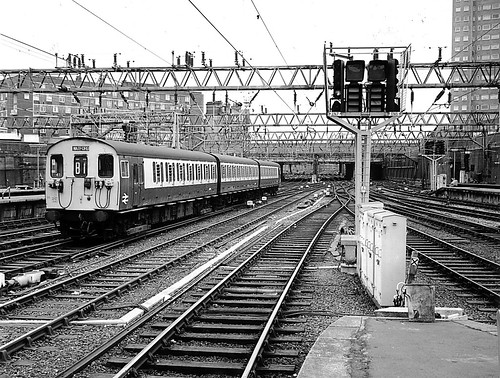It may come as a surprise, but there is spare capacity on the route into London Euston, all the way out to Queen's Park.
These are the so-called New Lines opened in 1912, which comprise a two-track suburban railway running from Euston to Watford, and now run by London Overground. At Queen's Park, trains from Euston are joined by Bakerloo Line trains which run northwards as far as Harrow and Wealdstone.
Between Euston and Queen's Park the service is lightly used, there being little traffic at the two stations, Kilburn High Road and the almost-deserted South Hampstead.
If the New Lines could be used by some of the outer suburban trains that run towards Milton Keynes and Northampton, this would release capacity on the four tracks of the main line. It would also be possible to extend the Bakerloo Line the 4km from Queen's Park to Willesden Junction.
How the route might be used
The details of such an arrangement would of course need working out. The lines follow a complex arrangement of burrowing junctions at Chalk Farm, which provide flexibility in routing, before entering the twin-bore tunnels at South Hampstead on the east side of the running lines. At Queen's Park, the northbound and southbound lines diverge, and the Bakerloo Line reaches the surface between them. Queen's Park station has island platforms between the Bakerloo and Overground tracks, and the remains of platforms on the four main line tracks.
The Bakerloo Line tracks continue parallel for a short distance, passing through car sheds before merging with the Overground tracks, which then continue on the east side of the main line until Willesden Junction, where there is a bay for terminating trains. The next stations northward are Harlesden and Stonebridge Park, and the line then dives under the main line tracks, continuing northwards on the west side of the main line tracks from Wembley Park to Carpenders Park. The New Lines then separate from the main line, calling at Watford High Street before reaching the terminus at Watford Junction.
The main difficulty that would need to be overcome is that the main lines are arranged (from west to east) down fast, up fast, down slow, up slow, which means that a grade-separated junction would be needed to enable trains on the slow lines to cross onto the Overground tracks without conflicting movements.
However, if only the stretch of line south of Willesden Junction, were taken over, which is adjacent to the slow lines, the difficulty of conflicting movements is much reduced. But that raises the question of what route a main line could follow from Willesden northwards.

Kommentarer
Having one big station that allows passengers to connect from the west (bristol, cardiff), the north west (birmingham, manchester) and the north east (newcastle, leeds) to european services seems the way to go. The alternative is having multiple stations near to each other built piecemeal; just like the "victorian system" that we are supposed to be hoping to get away from.
Is the new expanded Euston (10 high speed platforms as described at the dft) designed to be able to cope with later network expansion??
An what about Birmingham to Paris? The current plans suggest two options - walk from Euston to St. Pancras, or perhaps at a later date there will be a connecting line - so where will international services start - Euston or St Pancras (or both). I can't even imagine what the planners think will be the solution.
Elsewhere it's been suggested the the best solution would be a through station replacing the London terminus - connecting to HS1 - this would be some couple hundred meters north-ish of Euston. Such a station would need subways or overways, and could replace Euston, Paddington, St. Pancras and maybe Kings Cross for long distance intercity travel - no doubt it would be a monstrosity, hated and unloved.
Has this even been planned for? My guess is no - we're still buiding bit by bit, as funds allow. But that isn't the only option - a megalomaniac (with a near monopoly) with a truly grand plan is what is needed - to build a London equivalent of York station - A single station serving many different needs, and built big and good enough to not need expanding for over 100 years.
I apologies for not covering the South of England, or intra-London traffic, as I really know little about it. A suitably grand solution for crossing London north-south is needed too - so that the south and southeast can visit their poorer cousins in the north in style. I look forward to your arrival.
Best wishes.
And of Course but a stone's throw away via Camden Road Station is a short connection Primrose Hill and Camden Ahed - oops we've built a Sainsburys on that land, and a library and a major project on Kings Cross Goods too - Could have been a great place to develop a major station and supporting lines on an E-W Axis noting that At W Hampstead it wopuld be possible to connect Marylebone(and Western) lines with NLR and Midland .... It really is amazing how often these radial routes actucllay cross over each other in secret (Wembley/Kenton(Harrow) Hackney (where there used to be a service NLR-GER) etc).
Crossrail also existed and has steadily been severed (Liverpool Street, Snow Hill, Kings Cross, Paddington, Kentish Town - all feeding in to the Widened Lines (AKA Crossrail Mk 1)